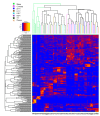Identification of a core bacterial community within the large intestine of the horse
- PMID: 24204908
- PMCID: PMC3812009
- DOI: 10.1371/journal.pone.0077660
Identification of a core bacterial community within the large intestine of the horse
Abstract
The horse has a rich and complex microbial community within its gastrointestinal tract that plays a central role in both health and disease. The horse receives much of its dietary energy through microbial hydrolysis and fermentation of fiber predominantly in the large intestine/hindgut. The presence of a possible core bacterial community in the equine large intestine was investigated in this study. Samples were taken from the terminal ileum and 7 regions of the large intestine from ten animals, DNA extracted and the V1-V2 regions of 16SrDNA 454-pyrosequenced. A specific group of OTUs clustered in all ileal samples and a distinct and different signature existed for the proximal regions of the large intestine and the distal regions. A core group of bacterial families were identified in all gut regions with clear differences shown between the ileum and the various large intestine regions. The core in the ileum accounted for 32% of all sequences and comprised of only seven OTUs of varying abundance; the core in the large intestine was much smaller (5-15% of all sequences) with a much larger number of OTUs present but in low abundance. The most abundant member of the core community in the ileum was Lactobacillaceae, in the proximal large intestine the Lachnospiraceae and in the distal large intestine the Prevotellaceae. In conclusion, the presence of a core bacterial community in the large intestine of the horse that is made up of many low abundance OTUs may explain in part the susceptibility of horses to digestive upset.
Conflict of interest statement
Figures




References
-
- Jalanka-Tuovinen J, Salonen A, Nikkilä J, Immonen O, Kekkonen R et al. (2011) Intestinal microbiota in healthy adults: Temporal analysis reveals individual and common core and relation to intestinal symptoms. PLOS ONE 6(7): e23035. doi:10.1371/journal.pone.0023035. PubMed: 21829582. - DOI - PMC - PubMed
Publication types
MeSH terms
Substances
Grants and funding
LinkOut - more resources
Full Text Sources
Other Literature Sources

